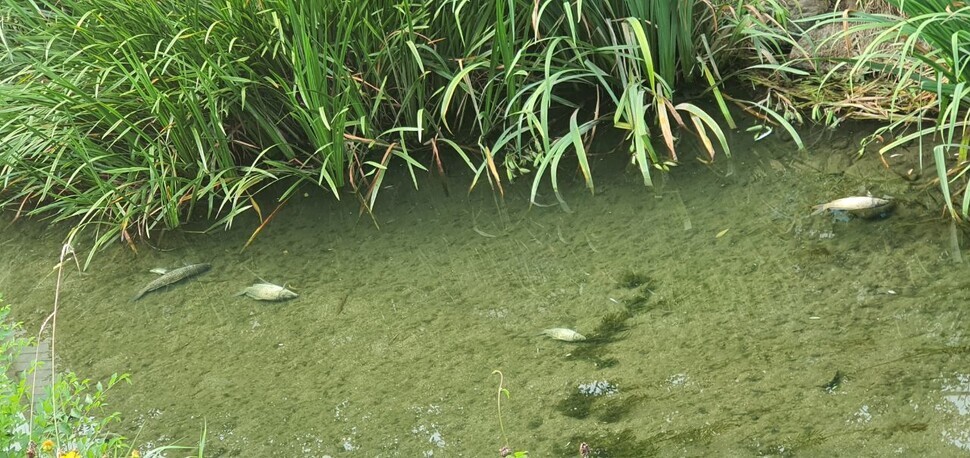hankyoreh
Links to other country sites 다른 나라 사이트 링크
Elevated water temperatures in Han River are causing mass deaths of fish, report says

The temperature of the Han River during the hot weather this July reached as much as 3.1°C higher than in past years.
The higher water temperatures were also found to have been a factor in the mass deaths of fish in the river.
The Seoul Metropolitan Government Research Institute of Public Health and Environment published a report Thursday titled “Estimated Water Temperatures in the Han River, 1994–2001 (28 Years).” According to the figures, the Noryangjin observation station measures an average high temperature of 26.7°C for the Han River during July.
The monthly average water temperature high represents the sum of the high temperatures calculated for each day of the month divided by the number of days. The number was 2.6°C higher than the average July high of 24.1°C for the preceding 27 years.
The Seonyu observation station similarly calculated an average high water temperature of 26.8°C for the year — 2.4°C higher than the 24.4°C for past years.
Some of the river’s tributaries had average high temperatures in excess of 30°C. According to the institute, the water temperature situation has reached severe levels, as the carp that live in large numbers in the Han and its tributaries cannot survive beyond the “critical temperature” of 32°C.
An observation station on Anyang Stream, one of the Han’s tributaries, recorded a July high of 31°C, or 3.1°C higher than the 28.1°C during past years. At other stations on the Jungnang and Tan Streams, figures were 2.3°C and 2.6°C higher, respectively.
The institute concluded that climate change was responsible for the higher water temperatures.
The average high temperature of 32.2°C for July was the second-highest in recorded history, after the 32.6°C recorded in 1994. Temperatures in the Han River have also been rising with greater frequency recently.
The July high temperature recorded at the Han’s Noryangjin station has exceeded 25°C a total of 11 times in the past 28 years; six of those times have come since 2014.
The institute also attributed the mass deaths of fish in the Han last month to the higher water temperatures. On July 15, around 30 common carp and other fish in Mokgam Stream were found dead in Seoul’s Guro District. The district office measured the water temperature there at 32.5°C at the time.
Similarly, around 400 crucian carp and other fish were found dead on July 24 at Jangji Stream in Seoul’s Songpa District. The water temperature at the time was 31.8°C.
An official with the institute’s water environment and ecology team said, “Tributaries are far more sensitive to temperature change than the Han River due to the shallow depths and low flow.”
“As water temperatures rise, this increases the metabolism and breathing of animals such as algae, microorganisms, and fish, while oxygen solubility decreases. Fish and other poikilotherms, in particular, may die off once the temperature increases beyond what they can withstand,” the official added.
The institute plans to expand its research into the relationship between water temperatures and summer heat, viewing the rise in temperatures associated with climate change as a potential threat to the river ecosystem.
Since 1993, the institute has been conducting measurements for temperature and 17 other water quality indicators every five minutes through its stations, which include two on the main course of the Han at Noryangjin and Seonyu and another three on Jungnang, Tan, and Anyang Streams, which are tributaries of the Han.
By Kim Yang-jin, staff reporter
Please direct comments or questions to [english@hani.co.kr]

Editorial・opinion
![[Column] Season 2 of special prosecutor probe may be coming to Korea soon [Column] Season 2 of special prosecutor probe may be coming to Korea soon](https://flexible.img.hani.co.kr/flexible/normal/500/300/imgdb/original/2024/0426/3317141030699447.jpg) [Column] Season 2 of special prosecutor probe may be coming to Korea soon
[Column] Season 2 of special prosecutor probe may be coming to Korea soon![[Column] Park Geun-hye déjà vu in Yoon Suk-yeol [Column] Park Geun-hye déjà vu in Yoon Suk-yeol](https://flexible.img.hani.co.kr/flexible/normal/500/300/imgdb/original/2024/0424/651713945113788.jpg) [Column] Park Geun-hye déjà vu in Yoon Suk-yeol
[Column] Park Geun-hye déjà vu in Yoon Suk-yeol- [Editorial] New weight of N. Korea’s nuclear threats makes dialogue all the more urgent
- [Guest essay] The real reason Korea’s new right wants to dub Rhee a founding father
- [Column] ‘Choson’: Is it time we start referring to N. Korea in its own terms?
- [Editorial] Japan’s rewriting of history with Korea has gone too far
- [Column] The president’s questionable capacity for dialogue
- [Column] Are chaebol firms just pizza pies for families to divvy up as they please?
- [Column] Has Korea, too, crossed the Rubicon on China?
- [Correspondent’s column] In Japan’s alliance with US, echoes of its past alliances with UK
Most viewed articles
- 1AI is catching up with humans at a ‘shocking’ rate
- 21 in 5 unwed Korean women want child-free life, study shows
- 3Korea’s 1.3% growth in Q1 signals ‘textbook’ return to growth, says government
- 4Division commander ordered troops to enter raging flood waters before Marine died, survivor says
- 5[Column] Park Geun-hye déjà vu in Yoon Suk-yeol
- 6[Column] Season 2 of special prosecutor probe may be coming to Korea soon
- 7Marriages nosedived 40% over last 10 years in Korea, a factor in low birth rate
- 8[Column] Has Korea, too, crossed the Rubicon on China?
- 9‘Weddingflation’ breaks the bank for Korean couples-to-be
- 10Is Japan about to snatch control of Line messenger from Korea’s Naver?